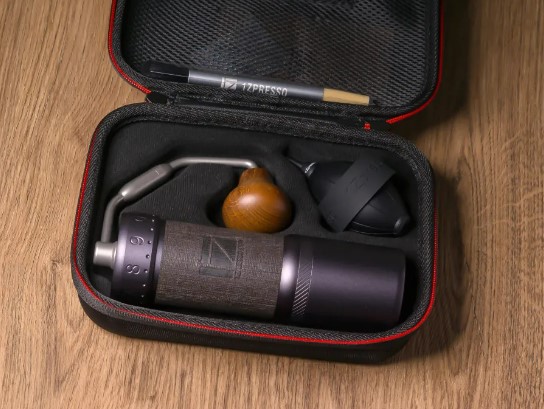Grind with Self-confidence: Experience the 1Zpresso J-Max Coffee Mill
Grind with Self-confidence: Experience the 1Zpresso J-Max Coffee Mill
Blog Article
Master the Art of Grinding Coffee Beans: A Guide to Coffee Grinders
For coffee lovers, the procedure of grinding coffee beans is greater than just a regular job; it is an art type that can greatly influence the taste and top quality of the final brew. Coffee mills play a critical duty in this fragile process, yet grasping their use entails greater than simply pressing a switch. Recognizing the nuances of various mill types, picking the ideal work size, and employing the right techniques are crucial actions in the direction of attaining that excellent mug of coffee. Nevertheless, the journey in the direction of becoming a coffee grinding master does not finish there. As we explore the complexities of this craft, we will uncover upkeep secrets, fixing tips, and a lot more, all focused on raising your coffee experience to brand-new heights.
Kinds of Coffee Grinders
There are 3 main sorts of coffee mills frequently used by coffee enthusiasts: blade grinders, burr grinders, and manual grinders. Blade mills are the most basic type, using an easy blade to chop the coffee beans. While they are affordable and easy to use, they typically cause unequal coffee grounds as a result of inconsistent grinding. Burr mills, on the various other hand, supply more accuracy by crushing the beans in between a moving grinding wheel and a non-moving surface. This causes an uniform grind dimension, which is important for a consistent coffee flavor. Burr grinders come in both level and conical forms, each offering somewhat different grinding qualities.
Manual mills, as the name suggests, require hands-on effort to grind the coffee beans. They are frequently preferred by those who appreciate the process of hand brewing coffee or for those that value portability. Manual grinders can vary in style, from easy handheld versions to a lot more complex countertop variations. While they might call for more initiative, manual grinders provide control over the grinding process, allowing individuals to readjust the work size to their choice. Each sort of coffee grinder has its advantages and ideal use instances, accommodating the diverse choices of coffee fanatics.

Selecting the Right Grind Dimension
With an understanding of the different kinds of coffee grinders, the next important step in achieving the perfect cup of coffee is choosing the right grind size. The work size plays a considerable function in determining the taste profile of your coffee (1Zpresso J-Ultra). Different brewing techniques call for certain work sizes to optimize the removal of flavors from the coffee grounds
For a rugged grind, ideal for French press and chilly mixture techniques, the coffee beans should look like breadcrumbs, supplying a durable and strong taste. Medium-coarse grinds, appropriate for Chemex or Clever Dripper, have an appearance comparable to rugged sand, supplying a well balanced taste.
Tool grinds, usually made use of in drip coffee machine, have an uniformity looking like routine sand, leading to a well-rounded flavor. Great grinds, ideal for coffee machines, are akin to salt, producing an abundant and intense taste. Ultimately, extra-fine grinds, utilized in Turkish coffee, are as great as powdered sugar and generate a solid and potent brew.
Grinding Methods for Optimum Taste
To draw out the greatest capacity of flavor from your coffee beans, understanding proper grinding techniques is necessary. Uniformity is crucial when it concerns grinding coffee beans for optimum flavor. Guaranteeing that the coffee beans are ground equally is vital to accomplish a well balanced extraction throughout the developing procedure. One of the fundamental strategies for enhancing taste is to readjust the grind dimension based on the brewing technique being utilized. A great work is suitable for coffee devices, while a crude grind is much more appropriate for French press brewing. Furthermore, the grinding time plays a substantial function in flavor removal. Over-grinding can lead to a bitter preference, while under-grinding might result in a sour taste. It is advised to try out different work sizes and brewing times to locate the perfect balance that fits your taste choices. By taking note of these grinding techniques, you can elevate the taste profile of your coffee and appreciate a more gratifying cup every time.
Upkeep and Cleaning Tips

In enhancement to routine cleansing, it is critical to evaluate your mill for any type of signs of wear or damage. Check the blades, burrs, and other components for any dullness or malfunctions. Replace any kind of damaged components promptly to maintain the top quality of your coffee grind. Lastly, store your grinder in a completely you can look here dry and clean environment to stop any wetness or dirt from influencing its you can try here efficiency. By following these maintenance and cleansing ideas, you can make certain that your coffee grinder proceeds to supply tasty freshly ground coffee for years to come.
Troubleshooting Common Mill Issues


Ensuring your coffee grinder functions efficiently calls for proficient troubleshooting of anchor typical problems that may arise during its usage. One usual problem with coffee grinders is irregular work dimension.
Another frequent problem is grinder obstructing. This can happen when oils from the coffee beans develop and block the grinder's chute. To resolve this, dismantle the mill and tidy all parts thoroughly, paying special interest to the chute and burrs. Additionally, bear in mind overfilling the receptacle to stop blockages.
Lastly, if your grinder is creating too much noise during procedure, it could show a trouble with the electric motor or inner elements. In such instances, it is recommended to consult the supplier's directions for repairing steps or seek expert assistance to diagnose and correct the problem quickly.
Final Thought
In verdict, understanding the art of grinding coffee beans involves understanding the various sorts of coffee grinders, selecting the right grind size, utilizing appropriate grinding strategies for optimal taste, and keeping and cleaning up the grinder frequently. By following these standards and fixing common mill problems, coffee fanatics can elevate their coffee developing experience and enjoy a delicious cup of coffee every time.
Report this page